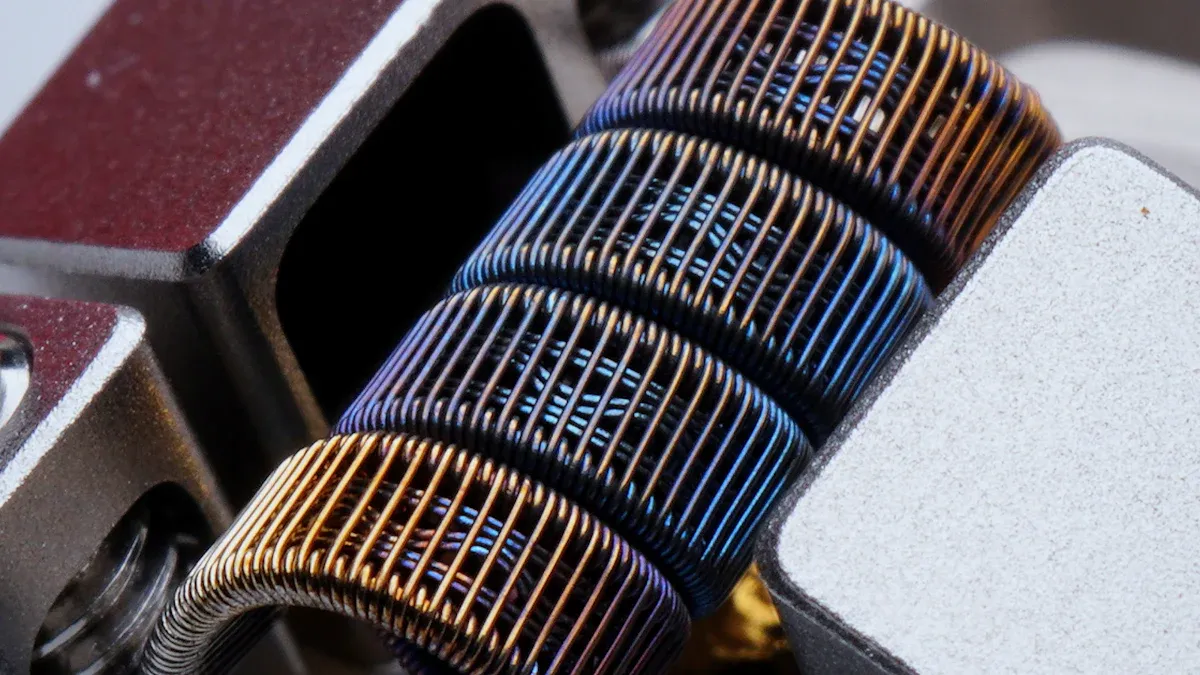
SiC heating element technology now features smarter controls, greater energy efficiency, and longer service life. Engineers see reduced operational costs and improved sustainability. These advancements help industries achieve higher performance. Some challenges remain, such as cost and supply chain issues, but the benefits continue to grow.
Key Takeaways
- New materials and designs make SiC heating elements last longer, heat faster, and use energy more efficiently.
- Modern SiC heating elements help industries save money by cutting energy use and reducing maintenance needs.
- SiC heating elements support many industries like semiconductors, batteries, and ceramics by providing reliable, high-temperature heating.
Key Innovations in SiC Heating Element Design

Advanced Material Compositions
Engineers now use new blends of silicon carbide and rare earth elements. These advanced materials help the SiC heating element resist oxidation and corrosion. They also allow the element to work at higher temperatures. Many manufacturers add nano-scale additives to improve conductivity. This change leads to faster heating and better energy use. The result is a SiC heating element that lasts longer and performs better in tough environments.
Novel Structural Designs
Designers have created new shapes and forms for the SiC heating element. Some use spiral or multi-leg structures to spread heat more evenly. Others use hollow cores to reduce weight and speed up heat transfer. These designs help industries save energy and lower costs. They also make it easier to fit the SiC heating element into different machines.
Note: New structures can also reduce the risk of hot spots, which helps prevent early failure.
Next-Generation Manufacturing Techniques
Modern factories use 3D printing and precision molding to make SiC heating elements. These methods allow for custom shapes and tight quality control. Automated systems check each element for flaws before shipping. This process means fewer defects and more reliable products. Companies can now produce SiC heating elements faster and with less waste.
SiC Heating Element Performance Improvements in 2025
Higher Energy Efficiency
Engineers have made significant progress in boosting the energy efficiency of SiC heating elements. These improvements come from better material purity and advanced control systems. Many factories now use sensors that monitor temperature in real time. These sensors help maintain precise heat levels and reduce wasted energy.
- New insulation materials keep more heat inside the system.
- Smart controllers adjust power output based on demand.
- Faster heat-up times mean less energy is lost during startup.
Tip: Companies that upgrade to modern SiC heating elements often see lower electricity bills and reduced carbon emissions.
Enhanced Durability and Lifespan
SiC heating elements now last much longer than before. Manufacturers use stronger materials and improved coatings to protect against oxidation and thermal shock. These changes help the elements survive harsh industrial environments.
A typical SiC heating element in 2025 can operate for thousands of hours without failure. Maintenance teams spend less time replacing parts. This reliability leads to fewer production stops and lower maintenance costs.
| Feature | 2020 Model | 2025 Model |
|---|---|---|
| Average Lifespan (hrs) | 3,000 | 5,000+ |
| Failure Rate (%) | 8 | 3 |
Expanded Temperature Capabilities
The latest SiC heating elements can reach higher temperatures than older models. Some designs now operate above 1,600°C. This capability opens new possibilities for industries that need extreme heat.
- Glass and ceramic manufacturers can process materials faster.
- Semiconductor plants achieve better results with higher process temperatures.
- Battery production lines benefit from more stable and uniform heating.
Note: Higher temperature limits also mean more flexibility in choosing the right heating element for each application.
Real-World Performance Examples
Many industries have already seen the benefits of these performance improvements. For example, a semiconductor factory in Texas replaced its old heaters with SiC heating elements. The factory reported a 20% drop in energy use and a 30% increase in uptime.
A ceramics company in Germany switched to the new generation of SiC heating elements. The company noticed fewer breakdowns and better product quality. Maintenance staff reported that the elements lasted twice as long as the previous models.
- Semiconductor plants: Improved yield and lower costs
- Ceramics factories: Fewer defects and longer production runs
- Battery makers: More consistent heating and faster cycle times
These real-world results show how SiC heating elements continue to set new standards for industrial heating.
Emerging Applications and Industry Adoption of SiC Heating Element

Growth in Semiconductor Manufacturing
Semiconductor factories now rely on advanced heating solutions to achieve precise temperature control. SiC heating elements help these facilities reach higher process temperatures and maintain stable conditions. Engineers report improved yields and fewer defects in microchip production. Many companies choose these elements for their ability to handle rapid temperature changes.
Adoption in Green Energy and Battery Production
Battery manufacturers use SiC heating elements to create uniform heat during electrode drying and cell assembly. This technology supports the production of lithium-ion and solid-state batteries. Green energy projects, such as solar panel manufacturing, also benefit from the high efficiency and durability of these elements. Consistent heating leads to better product quality and longer equipment life.
Note: Reliable heating plays a key role in scaling up battery and renewable energy production.
Use in Advanced Ceramics and Glass Processing
Ceramics and glass industries require extreme heat for shaping and finishing products. SiC heating elements provide the high temperatures and fast response times needed for these processes. Operators see fewer product defects and faster production cycles. The elements also reduce downtime, which helps companies meet tight deadlines.
Automotive and Emission Control Systems
Automotive manufacturers use SiC heating elements in emission control systems and thermal management units. These components help vehicles meet strict environmental standards. The elements support rapid heating for catalytic converters and battery systems in electric cars. As a result, automakers achieve better performance and lower emissions.
Challenges and Opportunities for SiC Heating Element Technology
Cost and Supply Chain Considerations
Manufacturers face rising costs for raw materials. Supply chain disruptions can delay shipments. Some companies invest in local sourcing to reduce risks. Others form partnerships with suppliers to secure steady material flow. Price fluctuations remain a challenge for many industries.
Sustainability and Environmental Impact
Many companies want to lower their carbon footprint. They choose materials that are easier to recycle. Factories now use cleaner production methods. These changes help reduce waste and energy use. Some organizations set goals for zero emissions in their heating processes.
Tip: Choosing sustainable materials can improve a company’s reputation and meet new regulations.
Integration with Smart Systems
Smart systems now monitor heating elements in real time. Sensors track temperature and performance. Automated controls adjust power to save energy. These systems help prevent breakdowns and extend equipment life. Operators receive alerts when maintenance is needed.
- Real-time data improves process control.
- Predictive maintenance reduces downtime.
Future Opportunities for Innovation
Engineers see many ways to improve heating technology. New materials may boost efficiency. Advanced designs could lower costs. Digital tools will help factories run smarter. The industry expects more breakthroughs in the next few years.
| Opportunity | Potential Benefit |
|---|---|
| New Materials | Higher efficiency |
| Smart Integration | Lower maintenance |
| Design Innovation | Reduced costs |
Recent advancements deliver higher efficiency, longer lifespan, and improved reliability. Industries now benefit from lower costs and better sustainability. Some challenges, like affordability and supply chain risks, remain. Experts expect continued innovation to expand the role of advanced heating technology across more industrial applications.
FAQ
What industries benefit most from SiC heating elements?
Semiconductor, battery, ceramics, glass, and automotive industries see the greatest benefits. These sectors require high temperatures, energy efficiency, and long-lasting performance.
How do SiC heating elements improve energy efficiency?
SiC heating elements heat up quickly and maintain stable temperatures. Smart controllers and advanced materials help reduce energy waste and lower operational costs.
Tip: Upgrading to SiC heating elements often leads to noticeable energy savings.
Are SiC heating elements difficult to maintain?
Most SiC heating elements require minimal maintenance. Automated monitoring systems alert operators to issues early, which helps prevent unexpected failures and reduces downtime.


